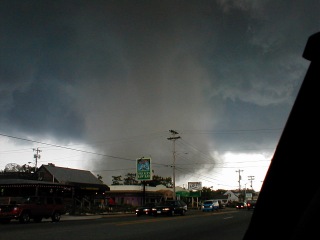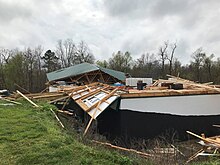Portal:Tornadoes
Note: Tornadoes are very dangerous and potentially deadly. Always take tornado warnings seriously and immediately seek shelter. |
The Tornadoes Portal

Selected tornado article -
Selected tornado list -
Selected image -

Selected tornado year -
Related portals
2024 tornado activity
Tornado anniversaries
June 6
- 1974 – Scattered tornadoes touched down across the Midwestern and Southeastern United States. An F3 tornado damaged or destroyed 300 homes in Forrest City, Arkansas, killing four people and injuring 112.
June 7
- 1947 – An F4 tornado passed south of Vienna, Ohio and through Sharon and Farrell, Pennsylvania, killing six people and injuring 340. About 150 buildings were destroyed, and many people were injured in the collapse of apartment buildings and factories.
June 8
- 1953 – One of the deadliest single tornadoes in U.S. history, an F5 tornado devastated portions of Flint and Beecher, Michigan, killing 116 people and injuring 844. Homes were obliterated along a mile-long stretch of one road. This was the last single tornado in the United States to kill more than 100 people until the 2011 Joplin tornado.
- 1966 – An F5 tornado tore through Topeka, Kansas, killing 16 people and injuring 450. About 820 homes were destroyed and 3,000 were damaged as entire neighborhoods were leveled. The cost of damage was estimated at $100 to $250 million, $939 to $2,348 million in 2023, making it one of the costliest tornadoes in U.S. history.
- 1984 – Just after midnight, an F5 tornado damaged or destroyed 90% of Barneveld, Wisconsin, including a subdivision of new houses, which was obliterated. More homes were destroyed in and near Black Earth. Nine people were killed and about 200 were injured. Residents were awoken by a loud clap of thunder just a few minutes before the tornado struck.
Did you know…
- ...that the 2013 Moore tornado that struck Moore and Newcastle, Oklahoma, is the most recent EF5 tornado?
- ...that the 2021 South Moravia tornado, an IF4 tornado with winds between 207–260 mph (333–418 km/h), was the strongest tornado to hit the Czech Republic in modern history?
General images -
Accompanying Hurricane Katrina's catastrophic coastal impacts was a moderate tornado outbreak spawned by the cyclone's outer bands. The event spanned August 26–31, 2005, with 57 tornadoes touching down across 8 states. One person died and numerous communities suffered damage of varying degrees from central Mississippi to Pennsylvania, with Georgia sustaining record monetary damage for the month of August. Due to extreme devastation in coastal areas of Louisiana and Mississippi, multiple tornadoes may have been overlooked—overshadowed by the effects of storm surge and large-scale wind—and thus the full extent of the hurricane's tornado outbreak is uncertain. Furthermore, an indeterminate number of waterspouts likely formed throughout the life cycle of Hurricane Katrina.
The outbreak began with an isolated F2 over the Florida Keys on August 26; no tornadoes were recorded the following day as the storm traversed the Gulf of Mexico. Four weak tornadoes were observed on August 28 as the hurricane approached land, each causing little damage. Coincident with Katrina's landfall, activity began in earnest on August 29 with numerous tornadoes touching down across Gulf Coast states. Georgia suffered the greatest impact on this day, with multiple F1 and F2 tornadoes causing significant damage; one person died in Carroll County, marking the first known instance of a tornado-related death in the state during August. A record 18 tornadoes touched down across Georgia on August 29, far exceeding the previous daily record of just 2 tornadoes for the month throughout the state. Activity diminished over the subsequent two days as the former hurricane moved northward. Several more tornadoes touched down across the Mid-Atlantic states before the cessation of the outbreak just after midnight local time on August 31. (Full article...)List of Featured articles and lists
|
|---|
Topics
Subcategories
Related WikiProjects
The scope of WikiProject Severe weather is to write articles about severe weather, namely thunderstorms and tornadoes. Their talk page is located here.
WikiProject Weather is the main hub for all articles that are weather-related. WikiProject Weather strives to improve articles in a variety of weather topics, including Tropical Cyclones, Severe Weather, General meteorology, Non-tropical Storms, Climate, Floods, Droughts and wildfires, Meteorological instruments and data, Meteorological Biographies, and Space Weather. If you would like to help, please visit the project talk page.
WikiProject Meteorology is a collaborative effort by dozens of Wikipedians to improve the quality of meteorology- and weather-related articles. If you would like to help, visit the project talk page, and see what needs doing. The project is currently being merged into WikiProject Weather.
WikiProject Tropical cyclones is a daughter project of WikiProject meteorology. The dozens of semi-active members and several full-time members focus on improving Wikipedia's coverage of tropical cyclones.
Wikipedia is a fully collaborative effort by volunteers. So if you see something you think you can improve, be bold and get to editing! We appreciate any help you can provide!
Things you can do
Wikimedia
The following Wikimedia Foundation sister projects provide more on this subject:
-
Commons
Free media repository -
Wikibooks
Free textbooks and manuals -
Wikidata
Free knowledge base -
Wikinews
Free-content news -
Wikiquote
Collection of quotations -
Wikisource
Free-content library -
Wikiversity
Free learning tools -
Wikivoyage
Free travel guide -
Wiktionary
Dictionary and thesaurus










































